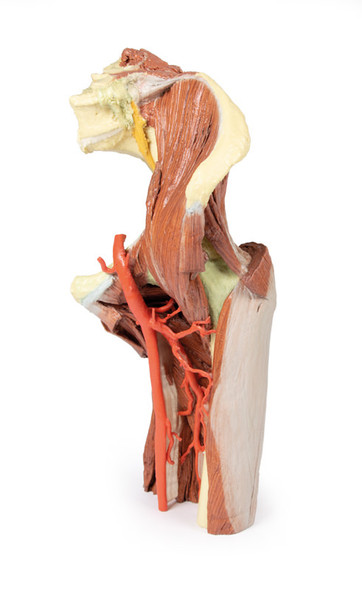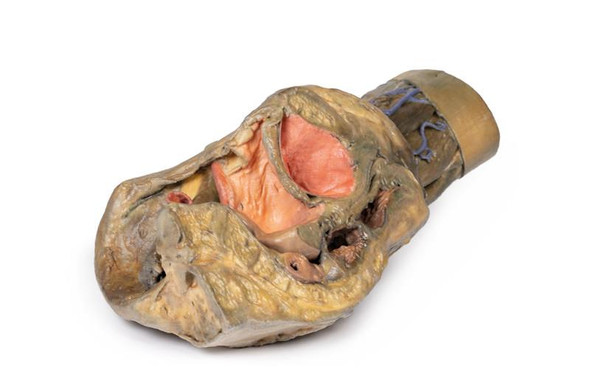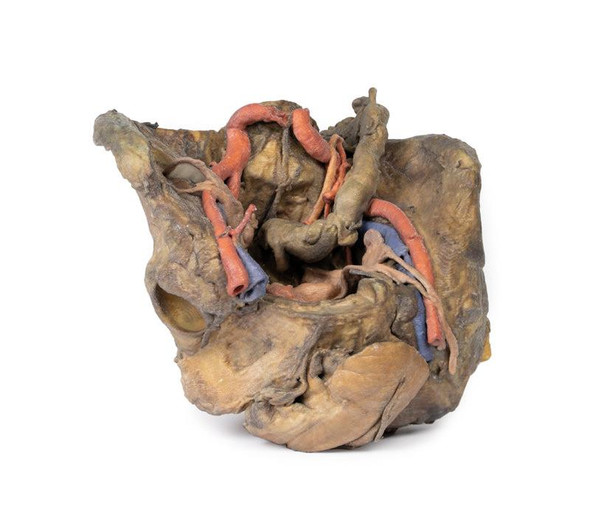Description
At the forefront of medicine and technology, we are proud to offer these incredible, uncompromised replicas of human anatomy. Using the latest 3D printing technology and materials available, this model is an exact replica of a human cadaver, brought to "life" by extensive medical scanning and manufacturing technologies. Over are the days of using ethically questionable cadavers, the mess of hazardous preservation chemicals, and the inaccuracies of plastinated models that often over-enhance anatomy for display, not realism. See the future, and the beauty, of real human anatomy with these incredible anatomical replicas!
This 3D printed female left pelvis and proximal thigh preserves both superficial and deep structures of the true and false pelves, inguinal region, femoral triangle, and gluteal region. The specimen has been sectioned transversely through the fourth lumbar vertebra, displaying the cross-section of the musculature (epaxial musculature, psoas and quadratus lumborum muscles) and cauda equina within the vertebral canal. The ventral and dorsal roots of the cauda equina are also visible exiting the intervertebral and sacral foramina in the sagittal section.
The abdominal aorta is preserved from the fourth lumbar vertebra to the bifurcation into the common iliac arteries; the root of the inferior mesenteric artery, lumbar arteries, and median sacral artery are also preserved. At the level of the sacral promontory, the common iliac artery bifurcates into the external and internal iliac arteries. Superficial to the sacral ventral rami the major branches of the internal iliac artery are visible (iliolumbar, lateral sacral, superior gluteal, inferior gluteal, internal pudendal, obturator, superior vesicle, obturator, uterine). These latter arterial branches pass to the sectioned bladder (collapsed against the pubis and receiving the ureters), uterus and vagina. The pelvic viscera (bladder, uterus, vagina and rectum) are visible in the midsagittal section extending to the anterior and posterior triangles of the perineum; in the anterior triangle the sagittal section of the clitoral body and part of the corpus spongiosum are visible inferior to the pubic symphysis.
The external iliac artery passes anteriorly along the pelvic brim, giving rise to the inferior epigastric and deep circumflex iliac arteries before passing deep to the inguinal ligament. The psoas major and minor muscles pass lateral to the external iliac artery, with the femoral nerve and lateral cutaneous nerve of the thigh resting on the superficial surface of the iliacus muscle.
The fascia lata inferior to the inguinal ligament has been removed to expose the muscular borders and contents of the femoral triangle (and surrounding anterior and medial thigh musculature). The great saphenous vein is visible joining the femoral vein adjacent to the femoral artery, with the branches of the femoral nerve just overlying the deep artery of the thigh. The distal cross-section through the proximal femur displays the anterior, medial and posterior compartment musculature, neurovascular bundles (femoral artery and vein, deep artery of the thigh, and the sciatic nerve), and tributaries of the great saphenous vein.
Posteriorly the gluteal region has been dissected to demonstrate deep structures. The gluteus maximus and gluteus medius muscles have been removed exposing the piriformis muscle. Superior to piriformis the superior gluteal artery and nerve pass laterally towards the gluteus minimus. Inferior to piriformis the inferior gluteal artery and nerve are visible (and pinned towards the sectioned edge of the gluteus maximus. The sciatic nerve and posterior cutaneous nerve of the thigh are also visible exiting the greater sciatic foramen inferior to the piriformis, running superficial to the lateral rotators (superior and inferior gemelli, obturator internus, quadratus femoris) and common origin of posterior thigh muscles (semitendinosus, semimembranosus, long head of biceps femoris) from the ischial tuberosity. The sacrotuberous ligament has been sectioned to show the internal pudendal artery and pudendal nerve exiting the greater sciatic foramen to wrap around the sacrospinous ligament and coccygeus muscle to enter the lesser sciatic foramen. The fat of the ischioanal fossa has been removed to demonstrate the course of these vessels in the perineum just lateral to the levator ani and external anal sphincter muscles.
Please Note: Thanks to the flexibility of manufacturing that 3D Printing offers, this model is "printed to order", and is not typically available for immediate shipment. Most models are printed within 15 working days and arrive within 3-5 weeks of ordering, and once an order is submitted to us, it cannot be canceled or altered. Please contact us if you have specific a specific delivery date requirement, and we will do our best to deliver the model by your target date.
Advantages of 3D Printed Anatomical Models
- 3D printed anatomical models are the most anatomically accurate examples of human anatomy because they are based on real human specimens.
- Avoid the ethical complications and complex handling, storage, and documentation requirements with 3D printed models when compared to human cadaveric specimens.
- 3D printed anatomy models are far less expensive than real human cadaveric specimens.
- Reproducibility and consistency allow for standardization of education and faster availability of models when you need them.
- Customization options are available for specific applications or educational needs. Enlargement, highlighting of specific anatomical structures, cutaway views, and more are just some of the customizations available.
Disadvantages of Human Cadavers
- Access to cadavers can be problematic and ethical complications are hard to avoid. Many countries cannot access cadavers for cultural and religious reasons.
- Human cadavers are costly to procure and require expensive storage facilities and dedicated staff to maintain them. Maintenance of the facility alone is costly.
- The cost to develop a cadaver lab or plastination technique is extremely high. Those funds could purchase hundreds of easy to handle, realistic 3D printed anatomical replicas.
- Wet specimens cannot be used in uncertified labs. Certification is expensive and time-consuming.
- Exposure to preservation fluids and chemicals is known to cause long-term health problems for lab workers and students. 3D printed anatomical replicas are safe to handle without any special equipment.
- Lack of reuse and reproducibility. If a dissection mistake is made, a new specimen has to be used and students have to start all over again.
Disadvantages of Plastinated Specimens
- Like real human cadaveric specimens, plastinated models are extremely expensive.
- Plastinated specimens still require real human samples and pose the same ethical issues as real human cadavers.
- The plastination process is extensive and takes months or longer to complete. 3D printed human anatomical models are available in a fraction of the time.
- Plastinated models, like human cadavers, are one of a kind and can only showcase one presentation of human anatomy.
Advanced 3D Printing Techniques for Superior Results
- Vibrant color offering with 10 million colors
- UV-curable inkjet printing
- High quality 3D printing that can create products that are delicate, extremely precise, and incredibly realistic
- To improve durability of fragile, thin, and delicate arteries, veins or vessels, a clear support material is printed in key areas. This makes the models robust so they can be handled by students easily.
























